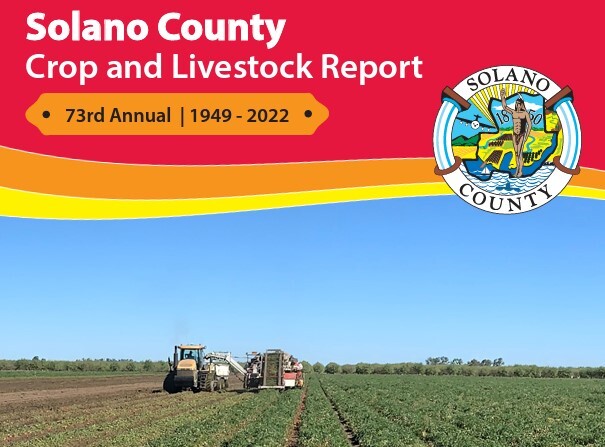 To view the 73rd Annual Solano County Crop and Livestock Report as well as historic crop and livestock reports, click on the image above.
73rd Annual Crop and Livestock Report
Tomatoes Regain Top Spot After Near Ten-Year Absence
The 73rd Annual Solano County Crop and Livestock Report reflects some significant changes to the list of top commodities and, to a lesser extent, total value, as a result of extreme weather events, issues at the ports and price fluctuations abroad.
Presented to the Board of Supervisors by Ag Commissioner Ed King and his staff on Tuesday, the report provides a look at how farming trends, the supply chain, as well as growing conditions, the economy and consumer demand impact not only our farm gate value, but what commodities our farmers and ranchers chose to bring to market. In 2022, the most recent year data is available, the gross value of Solano County’s agricultural production was $390,881,000. This represents a $16,761,000 decrease, or 4 percent downturn over 2021.
One highlight in each year’s report is the listing of the top ten commodities by value. The 2022 harvest reflects a shift from almonds holding the top spot, to tomatoes ($47,353,000), which haven’t been the County’s top commodity for nearly a decade. Otherwise, little has changed in the ranking since last year except for sunflower, which has dropped out of the top ten and been replaced by pollinators.
The remaining top crops of 2021 are as follows:
- Nursery products - $43,698,000
- Cattle and calves - $36,218,000
- Alfalfa - $30,946,000
- Wine grapes - $26,164,000
- Almonds – $21,290,000
- Walnuts - $11,304,000
- Pollination - $9,340,000
- Sheep and lambs - $9,074,000
- Prunes - $9,009,000
Overall, Solano County farmers and ranchers produce 80 commodities that can not only be found in any of the seven famers markets certified by the Ag Commissioner, but across the world, as Solano County’s crops were exported to 41 countries last year.
The accomplishments of Solano County’s farmers come despite California being hampered not only by several years of drought conditions, but supply chain issues at our ports and the challenges of navigating a global pandemic. Weather is also one of the greatest determining factors in any growing season and 2022 had two significant weather-related events that hampered growers. First there were freezing temperatures in February that severely damaged the developing almond, olive, cherry and apricot crops. This damage was severe enough for the USDA to approve a disaster declaration for 16 counties due to the freeze. The second weather challenge came in early September when a heatwave brought nine consecutive days of triple-digit heat, damaging grapes still hanging on the vine. The unpredictability of Mother Nature was on full display when mid-September rains put a temporary halt on tomato harvest.
The combination of heat followed by rain also gave rise to mold and poor kernel color in the walnut crop in 2022, and after several years of lower prices due to falling demand for walnut exports, we are starting to see walnut orchards being torn out. In 2022, the price per pound of walnuts was 40 cents or less, while the typical break-even point for a farmer is 70 to 90 cents per pound. In Solano County, Ag Commissioner Ed King estimates about 1,000 acres have already come out of production – about 10 percent of the total acreage planted to walnuts. Yet, it wasn’t but five years ago that walnuts were our top crop with a value around $50 million – a significant shift from last year’s walnut crop that barely topped $11 million. The California Walnut Commission anticipates $1 billion in losses from the 2022 crop.
Despite the pressure that Mother Nature and market fluctuations place on any farming operation, Solano County’s farmers and ranchers in many cases protect themselves by diversification in the crops they grow. Solano County farmers and ranchers produce 80 crops or commodities and have the distinction of making Solano County the 2nd most diverse Ag county in the state. This is largely thanks to the 1.6-million-acre-feet of water storage behind Monticello Dam at Lake Berryessa. Each year we receive the Crop and Livestock Report, I am reminded of the handful of visionaries who fought for and lobbied the federal government to build the Monticello Dam in the 1950’s. It changed the face of agriculture in this county and allowed our cities to grow.
It is also important to note the Ag Commissioner and his staff perform a number of important functions throughout the year that for the most part go unnoticed. One of those is acting as the Sealer of Weights and Measures. If you’ve pumped a gallon of gas, paid a taxi fare or bought anything that is sold by the pound at the grocery store, you’ve likely seen the county seal sticker that indicates the measuring device has been inspected and is accurate. Our Ag inspectors also check vehicle and railway scales, livestock scales as well as certain retail water meters and gas meters. This is done to ensure that the consumer is getting what they pay for.
Another critical function of the Ag Commissioner is pest exclusion, detection and eradication. Last year, more than 7,000 shipments of plant material, seed and household goods were inspected. A total of 81 shipments were rejected for live pests, material not properly certified or improper container markings.
The department’s pest detection team is the second line of defense against invasive pests. Early detection of pests is critical to ensure they do not gain a foothold here in Solano County.
Eradication efforts continue in north Vacaville where the Glassy-winged sharpshooter was found in a residential neighborhood two years ago. This pest spreads Peirce’s Disease, which can be devastating to wine grapes and other crops. With help from the state Department of Food and Agriculture, our Ag inspectors have continued to monitor through trapping and surveys, along with treatments to affected properties.
I would like to thank Solano County’s Agriculture/Weights and Measures staff for their hard work to ensure the sustainability of agriculture. I am also appreciative of the farmers and ranchers who cooperate with the department to make the annual Crop and Livestock Report possible.
To view the report online, visit: Solano County Crop and Livestock Report
 |
|
Since 2003, Supervisor John M. Vasquez has had the privilege to represent the 4th Supervisorial District covering Northern Solano County. The district includes portions of Vacaville and Dixon. He can be reached at (707) 784-6129 or JMVasquez@SolanoCounty.com. |
|